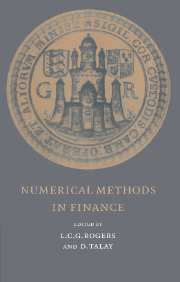Book contents
- Frontmatter
- Contents
- Contributors
- Introduction
- Convergence of Numerical Schemes for Degenerate Parabolic Equations Arising in Finance Theory
- Continuous-Time Monte Carlo Methods and Variance Reduction
- Recent Advances in Numerical Methods for Pricing Derivative Securities
- American Options: A Comparison of Numerical Methods
- Fast, Accurate and Inelegant Valuation of American Options
- Valuation of American Option in a Jump-diffusion Models
- Some Nonlinear Methods for Studying Far-from-the-money Contingent Claims
- Monte Carlo Methods for Stochastic Volatility Models
- Dynamic Optimization for a Mixed Portfolio with Transaction Costs
- Imperfect Markets and Backward Stochastic Differential Equations
- Reflected Backward SDEs and American Options
- Numerical Methods for Backward Stochastic Differential Equations
- Viscosity Solutions and Numerical Schemes for Investment/Consumption Models with Transaction Costs
- Does Volatility Jump or Just Diffuse? A Statistical Approach
- Martingale-Based Hedge Error Control
- The Use of Second-Order Stochastic Dominance To Bound European Call Prices: Theory and Results
Martingale-Based Hedge Error Control
Published online by Cambridge University Press: 05 June 2012
- Frontmatter
- Contents
- Contributors
- Introduction
- Convergence of Numerical Schemes for Degenerate Parabolic Equations Arising in Finance Theory
- Continuous-Time Monte Carlo Methods and Variance Reduction
- Recent Advances in Numerical Methods for Pricing Derivative Securities
- American Options: A Comparison of Numerical Methods
- Fast, Accurate and Inelegant Valuation of American Options
- Valuation of American Option in a Jump-diffusion Models
- Some Nonlinear Methods for Studying Far-from-the-money Contingent Claims
- Monte Carlo Methods for Stochastic Volatility Models
- Dynamic Optimization for a Mixed Portfolio with Transaction Costs
- Imperfect Markets and Backward Stochastic Differential Equations
- Reflected Backward SDEs and American Options
- Numerical Methods for Backward Stochastic Differential Equations
- Viscosity Solutions and Numerical Schemes for Investment/Consumption Models with Transaction Costs
- Does Volatility Jump or Just Diffuse? A Statistical Approach
- Martingale-Based Hedge Error Control
- The Use of Second-Order Stochastic Dominance To Bound European Call Prices: Theory and Results
Summary
Introduction
In the seminal paper of Black & Scholes (1973), the payoff on a European option is replicated perfectly by a dynamic strategy in the underlying security and a zero-coupon bond. Hence, the price of the replicating portfolio determines the no-arbitrage value for the option. Since that work of Black and Scholes, option pricing has been following this standard pattern of first specifying a perfect dynamic hedge, followed by an exploration of the pricing implications of the absence of arbitrage.
In Black–Scholes model, markets are complete in the sense that the payoff on the option is attainable through a dynamic trading strategy in the underlying stock and a money account. In practice, however, some of their assumptions can be proven wrong. Foremost, volatility is stochastic. In the absence of an asset that is instantaneously perfectly correlated with the volatility of the stock, market completeness is thereby invalidated. Likewise, actual rebalancing necessarily occurs over discrete intervals of time, in contrast with Black-Scholes continuous rebalancing.
If markets are incomplete, a blind application of complete-markets hedging strategies seems inappropriate. Most importantly, such policies do not self-correct even if a significant deviation from the target payoff is apparent. That immediately raises the question of whether there are hedging strategies that continuously correct in a way that facilitates error control. In other words, are there policies that adjust to past tracking errors such that the stochastic characteristics of the total tracking error become wellspecified?
- Type
- Chapter
- Information
- Numerical Methods in Finance , pp. 290 - 304Publisher: Cambridge University PressPrint publication year: 1997



